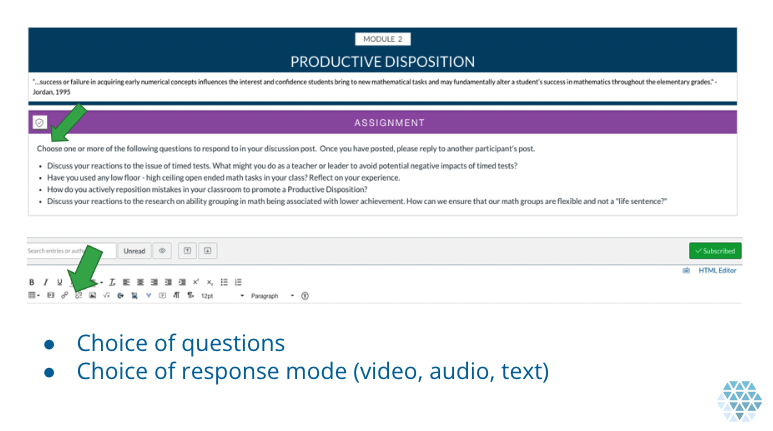The Value of Choice
Offering choices in the classroom (or in the home for that matter) can be a huge key to increasing authentic engagement for learners. I’ve experienced this first hand as a parent and as an educator, but the research also backs this up. If you’ve ever heard me speak, you already know that I’m a big fan of Universal Design for Learning (UDL). Engagement is one of the 3 principles of UDL. Engagement through the lens of UDL is more than just bells and whistles; it’s about creating expert learners who are purposeful and motivated.
Affect represents a crucial element to learning, and learners differ markedly in the ways in which they can be engaged or motivated to learn. There are a variety of sources that can influence individual variation in affect including neurology, culture, personal relevance, subjectivity, and background knowledge, along with a variety of other factors. Some learners are highly engaged by spontaneity and novelty while others are disengaged, even frightened, by those aspects, preferring strict routine. Some learners might like to work alone, while others prefer to work with their peers. In reality, there is not one means of engagement that will be optimal for all learners in all contexts; providing multiple options for engagement is essential.
(Source: https://udlguidelines.cast.org/engagement)
This post is about choice so we will focus on UDL Checkpoint 7.1 - optimize individual choice and autonomy. If you have ever parented or taught a challenging, independent child, you have likely already experienced the value of choice. It can be the difference between 2 bathroom breaks during a lesson or excited engagement. In order for offering choice to be a sustainable strategy to increase engagement the choices must be:
purposeful
acceptable to you.
You can get some great ideas for what choices to offer by administering an interest inventory to students at the beginning of a semester or school year. This will give you an idea of what your students are interested in and what will get them excited.
Purposeful
You decide what the choices are based on the goal you are trying to accomplish. For example, if it’s silent reading time and I want students to engage with a good book, then can they have a choice of sitting at their desk, sitting on the carpet, sitting in a corner, sitting in the teacher’s chair, etc? Can they have a choice of which book they read? Often times I see all students being told what to read, when to read, where to sit and a frustrated teacher because so many students are off task.
Acceptable to You
When you offer students a choice you have to be okay with what they choose. It can’t be a choice of do your work or not. Not doing the assignment isn’t a viable option, so instead maybe they choose if they want to start at the top of the page or the bottom of the page (this could work with math problems, but wouldn’t necessarily work for all subjects). Could they choose what they write with - pencil, erasable pen, colored pencil, etc? Could they choose if they want to answer all of the even questions or all of the odd questions? In a math word problem can they choose which numbers to put in the blanks in the problem to be able to challenge themselves?
“If school is not inviting, if the tasks are not clear, interesting, and at an appropriate level, how can we expect pupils to be on task? Adverse student reactions should be expected when classes are dull, teaching is uninspired, and failure is built in. Their oppositional behavior is a sign of personal health and integrity.”
Choice in Online or Blended Learning
The choices that you offer may look different if you are using a learning management system (LMS) like Canvas for online or blended learning. For example, if you are using the discussion board feature there are effective ways to offer choice. As previously stated about choices that are acceptable to you, not doing the discussion board likely would not be a choice. Here are some ways to incorporate choice in an LMS that are purposeful and may be acceptable to you:
Post 3-5 questions and offer students of choice of which question they would like to respond to. There may be one component of the reading or discussion topic that is of higher interest to the learner. Choice of which question to answer allows them to focus on something they WANT to talk about.
Offer a choice in response mode. Through the rich content editor Canvas allows students to respond via text, audio, video and include links, graphics, and more. Sometimes typing can be a barrier for students. This could be because they never really learned how to type, or they broke their arm or they struggle to sustain attention during tedious tasks. If this is the case, the choice of recording an audio response to the question or a video response can help eliminate the root problem. It could be that the option to add in pictures and links helps them to better make their point and is more interesting for peers to read and respond to than all text entries.
Considerations
Where are you able to incorporate choice in your classroom or home?
Which students do you think will benefit the most from choice?
If you spend time coming up with purposeful, acceptable choices will you spend less time dealing with behavioral concerns?
Explore Further
Check out this great article from Tamera Musiowsky-Borneman and Christine Arnold called Can Student Choice Promote Agency?
In our workshops and webinars on How to G.R.O.W. Successful Learners the “O” stands for Offer Choices where we help you bring this work to life at your site. Schedule your free consultation to discuss bringing this workshop in for your team or staff.

